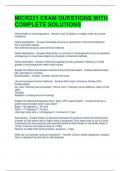MICR221 EXAM QUESTIONS WITH
COMPLETE SOLUTIONS
Define death of microorganisms - Answer-Loss of ability to multiply under any known
conditions
Define sterilisation - Answer-Complete removal or destruction of all microorganisms
from inanimate objects.
Non-selective physical and chemical methods
Define disinfection - Answer-Destruction or removal of microorganisms (but not bacterial
endospores) on inanimate objects by physical or chemical methods
Define antisepsis - Answer-Chemicals applied to body surfaces to destroy or inhibit
growth of microorganisms within host tissues
Explain the difference between bacteriocidal and bacteriostatic - Answer-Bacteriocidal =
kills, decrease in numbers
Bacteriostatic = inhibits, numbers remain the same
List some physical control methods - Answer-Moist heat: Autoclave, Boiling H2O,
Pasteurisation
Dry heat: Flaming and incineration, Hot air oven, Freezing (not as effective, does not kill
cells)
Filtration
Radiation (ionising and non-ionising)
Explain the difference between batch, flash, UHT pasteurisation - Answer-Done by a
plate heat exchanger which uses steam
Batch = 63 degrees C, 30 mins
Flash = 71 degrees C, 15 secs
Ultra high temp milk = 140 degrees C, minimum of 1 sec
Autoclaving - Answer-Steam is important because the pressure raises the boiling point
of water so that steam with a higher temp is produced. Pure steam and no air is crucial,
it denatures the key enzymes and essential proteins which leads to cell death (temp is
121dc) mixed air and steam (temp is 112dc)
Need to consider both temp and time, pressure = 15psi
What can you sterilise using an autoclave? - Answer-Culture media, glassware, surgical
items, materials from the lab for safe disposal
,What can't be autoclaved? - Answer-Plastics, toxic chemicals, heat-liable compounds
(antibiotics), heat sensitive equipment
Describe the relationship between death and temperature - Answer-Death is an
exponential function and thus occurs more rapidly as heat is raised
To sterilise or reduce a population it will take longer at lower temperatures than at
higher temperatures
What is the importance of a control? - Answer-For comparison, to test if the organism is
viable and to see if the treatment is effective
Explain what the thermal death point is - Answer-The lowest temperature required to kill
all cells in a standard suspension of bacteria in a liquid culture within 10 minutes
What is the method for determining the thermal death point? - Answer-Bacteria are
exposed for the same amount of time to different temperatures, the agar plate is
inoculated and the lowest temp with no growth = thermal death point
Explain what the thermal death time is - Answer-The length of time required to kill all of
the cells in a standard suspension of bacteria in a liquid culture at a given temperature
What is the method for determining the thermal death time? - Answer-Bacteria are
exposed at the same temperature but for differing amounts of time, the agar plate is
inoculated and the shortest time period with no growth = thermal death time
What is the decimal reduction time? - Answer-The length of time taken to obtain a ten-
fold reduction in the number of bacteria in a standard suspension of bacteria in a liquid
culture
-10 fold reduction = 90% killed = 1 log difference
-Measured in a 60 degree water bath
(see graphs in book)
What is the death rate constant? - Answer-K = 2/3t x log10 (Nt/No)
Shape of the curve
What is the Z value? - Answer-The temperature required for one log10 reduction in the
D value (track across from two log reduction with the difference of one, and down on the
x axis to minus the temperature difference)
Filtration - Answer-Filtration through filter with pores too small for for microorganisms
but large enough to allow liquid or air to pass through
Pore size is usually 0.2um to filter out bacteria (0.0um for myocoplasma - doesnt have a
cell wall so very flexi and can squeeze through the larger pores
Describe the depth filter - Answer-Random array of overlapping fibres, thick/deep (5-
10mm from top to bottom) usually made from glass or asbestos
, What are the advantages of a depth filter? - Answer-High dirt handling capacity, good
for highly contaminated solutions, can trap a lot of bacteria
What are the disadvantages of a depth filter? - Answer-Retains a lot of fluid (lost within
the filter), bad if it is an expensive solution - such as antibiotics
Describe the membrane filter - Answer-More regular pores, very thin, made from
cellulose acetate or cellulose nitrate
What is the advantage of a membrane filter? - Answer-Doesn't retain liquid
What are the disadvantages of a membrane filter? - Answer-Acts as a sieve, bacterial
contaminants collect on the surface of the filter causing blockages
Describe a nucleopore filter - Answer-Very clear pores, low numbers of pores per filter,
polycarbonate films are processed to make sure they have uniform pores
What is the advantage of the nucleopore filter? - Answer-Can be used to prepare
samples for electron sacnning microscopy
What is the disadvantage of the nucleopore filter? - Answer-Not many pores therefore a
much slower flow rate
Give some examples of solutions that can be filtered - Answer-Tissue culture media,
serum, antibiotic solutions, gases, filtered beer, observation of microbes from pond
water
What is a HEPA filter? - Answer-Laminar flow hood for basic specimen protection
Class 2 biological safety cabinets (for protecting specimen, user and environment from
contamination)
Describe non-ionising radiation - Answer-Applications include the sterilisation of
benches, air, water/waste water (in thin streams)
Not used to serilise large volumes of water as it cannot penetrate to a significant depth
eg. UV radiation = wavelength 260nm damages the DNA in the cell by forming
pyramidine dimers (thymine dimers-covalent chemical bonds, conformational change
resulting in death) or direct protein damage
What is the SOS response? - Answer-Error prone repair mechanism
Normal = no thymine dimers, LexA protein represses the production of SOS repair
enzymes (negative feedback system)




